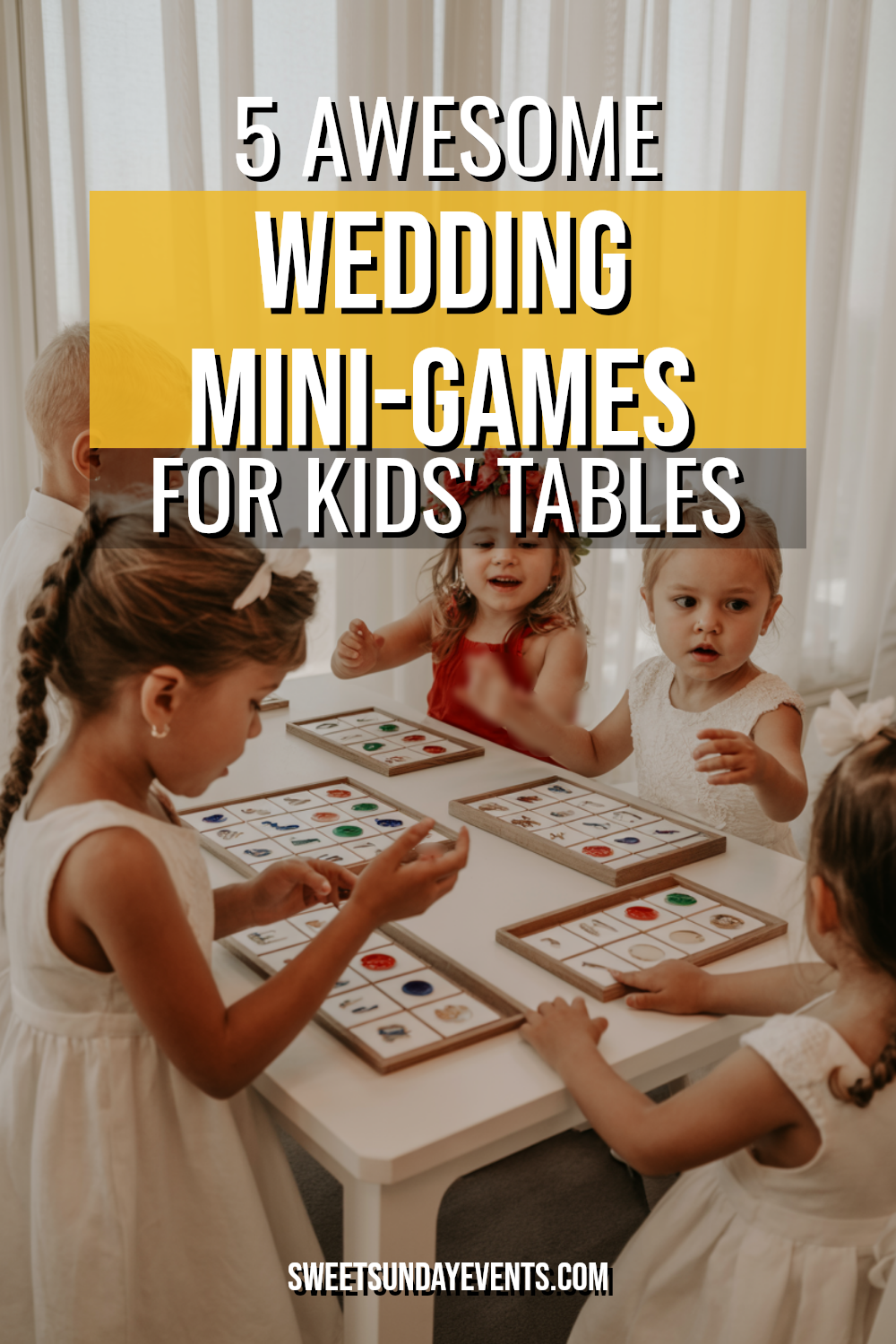Nothing kills the romantic vibe quite like a toddler’s meltdown during your vows. Smart couples know that keeping little guests entertained isn’t just thoughtful—it’s survival.
Here are five tried-and-tested mini-games that’ll turn your kids’ table from chaos central into the most coveted spot at your reception.
1. Wedding Bingo
Picture this: instead of disrupting your ceremony with random shouts of “I need the bathroom,” kids are quietly scanning for Uncle Bob’s terrible dance moves on their bingo cards.
Wedding bingo transforms passive observers into engaged participants who actually want to pay attention.
Create custom bingo cards featuring wedding-specific items and moments. Think “bride laughs,” “someone cries happy tears,” “flower girl drops petals,” or “groomsman adjusts tie.”
The beauty lies in how it redirects their natural tendency to notice everything into a structured game.
Creating the Perfect Cards
Design cards with a mix of guaranteed wins and rare spotting opportunities. Include obvious elements like “cutting the cake” alongside wildcards such as “someone takes off their shoes to dance.”
This ensures every child gets multiple victories throughout the evening.
Consider age-appropriate variations—picture cards for non-readers and word-based versions for older kids. Having different difficulty levels prevents the eight-year-old from completely dominating the four-year-old, which trust me, you want to avoid.
Prize Strategy
Small, individually wrapped prizes work better than one grand prize that’ll cause tears. Think stickers, mini coloring books, or fancy pencils. The goal is celebrating participation, not creating a competitive nightmare that requires parental intervention.
Rotate prize-giving throughout the event rather than saving everything for the end. Kids’ attention spans don’t stretch to “we’ll announce winners during dessert,” and frankly, neither do most adults after the open bar kicks in.
2. Scavenger Hunt Adventures
Transform your venue into an exploration playground with carefully crafted scavenger hunts. Unlike bingo’s passive observation, this gets kids moving purposefully rather than running around aimlessly (and potentially into waitstaff carrying hot plates).
Design hunts that work within your venue’s constraints and your photographer’s needs. Items like “find something blue,” “spot a bow tie,” or “locate the guest book” keep kids engaged without disrupting key moments or restricted areas.
Venue-Specific Adaptations
Outdoor weddings offer natural treasures—specific flowers, interesting rocks, or particular trees. Indoor celebrations might focus on architectural details, decorative elements, or even other guests’ accessories (with permission, obviously).
Coordinate with your venue coordinator to establish boundaries. Some areas might be off-limits, and you’ll want kids avoiding the kitchen, bridal suite, or anywhere expensive things might get knocked over by enthusiastic treasure hunters.
Team vs. Individual Play
Pairing older kids with younger ones creates natural mentorship and prevents anyone from feeling left out. Mixed-age teams also reduce the likelihood of one child finishing dramatically before others, which tends to end in tears.
Individual hunts work better for smaller groups or when you have kids who prefer working alone. Just ensure the difficulty level matches each child’s capabilities—nothing ruins a scavenger hunt quite like a frustrated six-year-old who can’t read the clues.
3. Creative Coloring Stations
Before you dismiss this as too simple, consider that coloring has become the adult stress-relief activity of choice for good reason.
For kids at weddings—surrounded by dressed-up strangers and expected to sit still—coloring provides the perfect calm-down activity.
Elevate basic coloring with wedding-themed pages featuring the couple’s names, wedding date, or even custom illustrations of the venue. Kids love feeling included in the celebration’s specifics rather than just being handed generic entertainment.
Supply Strategy
Invest in quality supplies that won’t frustrate little hands. Broken crayons and dried-out markers turn peaceful coloring time into meltdown central faster than you can say “I do.”
Washable everything is non-negotiable unless you enjoy explaining crayon marks to venue managers.
Create individual supply kits rather than communal sharing stations. Nothing starts kid-table drama quite like fighting over the good purple crayon. Small containers or bags with each child’s name eliminate territorial disputes before they begin.
Display and Keepsake Options
Set up a designated display area where completed artwork can be showcased. Kids beam with pride seeing their creations honored, and parents appreciate having something tangible from the celebration (besides cake-stained clothing).
Consider incorporating the artwork into your wedding somehow—perhaps as part of a memory book or displayed during the reception. This transforms the activity from mere distraction into meaningful participation in your special day.
4. Memory-Making Photo Booth
Kids are natural performers who love cameras, making a dedicated photo booth their personal stage.
Unlike formal wedding photography that requires standing still and smiling on command, photo booths encourage the silly, spontaneous moments that actually capture their personalities.
Set up a simple backdrop with wedding-themed props sized for little hands. Think mini bow ties, child-sized veils, funny signs, or oversized glasses. The key is providing enough variety that each child finds something that speaks to their individual sense of fun.
Technical Considerations
Instant cameras work beautifully for this age group—the immediate gratification of watching photos develop feels magical in our digital world. Kids can take home their creations while you keep copies for your wedding album.
If using digital options, consider tablets or phones with simple camera apps. Assign a responsible older child or adult volunteer to help with technical aspects while letting kids direct their own photo sessions.
Props and Backgrounds
Avoid anything too precious or easily broken. Kids get enthusiastic with props, and you don’t want to spend your reception supergluing decorative elements back together. Sturdy, washable items survive the inevitable drops and enthusiastic handling.
Create a simple backdrop using fabric, balloons, or even a decorated poster board. Elaborate setups look impressive but often overwhelm young children who just want to grab props and start posing. Sometimes simple truly is better.
5. Interactive Story Building
Channel kids’ natural storytelling abilities into a collaborative wedding story that involves your celebration. This quieter activity works perfectly during dinner service when you need sustained attention without much movement or noise.
Start with a simple prompt related to your wedding—perhaps how you met, your proposal story, or imaginary adventures you might have on your honeymoon. Each child adds a sentence or two, building an increasingly creative (and often hilarious) narrative.
Age-Appropriate Modifications
Younger children might contribute single words or phrases rather than complete sentences. Older kids can take on more complex storytelling roles, perhaps even serving as scribes for the group effort.
Consider providing story starter cards with prompts like “The bride and groom decided to travel to…” or “At the wedding, a magical thing happened when…” These help shy children participate without feeling pressured to create from nothing.
Documentation and Sharing
Record the stories in a special notebook or even audio format if possible. These often become treasured keepsakes that are far more entertaining to revisit than traditional guest book entries.
Share excerpts during the reception if appropriate—kids love hearing their creative contributions acknowledged in front of the grown-ups. Just preview content first to avoid any accidentally inappropriate additions that seemed hilarious to seven-year-olds.
Implementation Tips and Timing
| Activity | Best Timing | Duration | Adult Supervision Needed |
|---|---|---|---|
| Wedding Bingo | Throughout ceremony/reception | Ongoing | Minimal |
| Scavenger Hunt | Cocktail hour | 20-30 minutes | Moderate |
| Coloring Station | Dinner service | 30-45 minutes | Minimal |
| Photo Booth | Reception | Ongoing | Light |
| Story Building | Dinner/quiet moments | 15-20 minutes | Moderate |
Stagger activities rather than presenting everything simultaneously. Kids get overwhelmed by too many choices and often end up engaged with nothing rather than deeply involved in one thing.
Designate a point person—whether a family member, friend, or hired sitter—to facilitate transitions between activities. This person doesn’t need to be constantly hands-on but should be available for questions, conflicts, or bathroom emergencies.
Making It All Work Together
The secret lies in reading your specific group of kids and adapting accordingly. Some children thrive on structured activities while others prefer free-form creativity. Having multiple options allows natural sorting based on personality and energy levels.
Prepare backup supplies and alternative activities for unexpected situations. Kids spill things, lose interest faster than anticipated, or sometimes reject activities they seemed excited about five minutes earlier.
Flexibility saves the day more often than perfect planning.
Creating Lasting Memories
These mini-games serve a purpose beyond mere distraction—they create positive associations with your wedding day that kids will remember fondly as they grow up.
Years later, they’ll recall the fun they had rather than how long they had to sit still or how boring adult parties can be.
The effort you put into including young guests thoughtfully demonstrates the kind of family-focused couple you are. Parents notice and appreciate when their children are genuinely welcomed rather than merely tolerated at celebrations.


